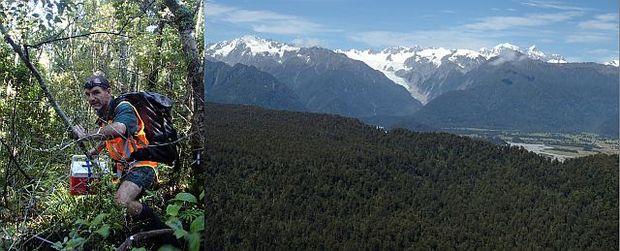
Jim Livingstone carries a rowi egg in a heated and padded chilly bin (left), and view across the Okarito Kiwi Sanctuary in the South Okarito Forest towards the Southern Alps and Franz Josef Glacier (images: A. Ballance)
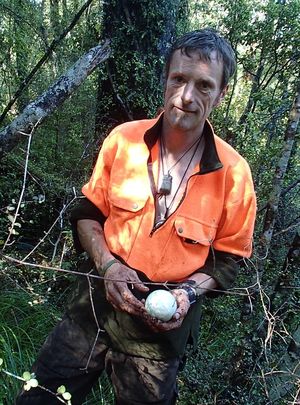 There are five different species of kiwi found in New Zealand, from Northland right down to Stewart Island. There are estimated to only be 72,000 or so kiwi surviving in the wild, and in unprotected populations numbers are declining at about 2-3 percent each year.
There are five different species of kiwi found in New Zealand, from Northland right down to Stewart Island. There are estimated to only be 72,000 or so kiwi surviving in the wild, and in unprotected populations numbers are declining at about 2-3 percent each year.
The rarest kiwi is the rowi, which is found only in the South Okarito Forest near Franz Josef on the West Coast. Its population was once as low as 150 but now numbers around 400 individuals, due to an intense management programme in which rowi eggs are collected from wild pairs at around 30 days of age to be hatched in captivity as part of Kiwis for Kiwi and BNZ Operation Nest Egg. 95% of rowi chicks are predated by stoats in the wild, so instead chicks are hatched in captivity, and then kept on a predator-free crèche island until they are about 1.2 kg in weight when they are considered large enough to be stoat-proof and are returned to either South or North Okarito forest.
Alison Ballance joins the Department of Conservation’s Jim Livingstone and Ieuan Davies (left, with rowi egg) on an egg rescue in the Okarito Kiwi Sanctuary, and hears how smart chick-timer transmitters worn by the male bird indicate when he has begun incubating an egg, and how the SkyRanger system flies over the South Okarito forest every fortnight during the breeding season to collect transmitter data from the monitored population.
Once Jim and Ieuan have collected the egg from the A. Harper pair (their second egg for the season) it is taken to the West Coast Wildlife Centre in Franz Josef where kiwi husbandry expert Kim Bryan-Walker checks and cleans the egg, and uses clear nail polish to fix a few cracks before putting it in an incubator which rolls it regularly and maintains it at optimal temperature.
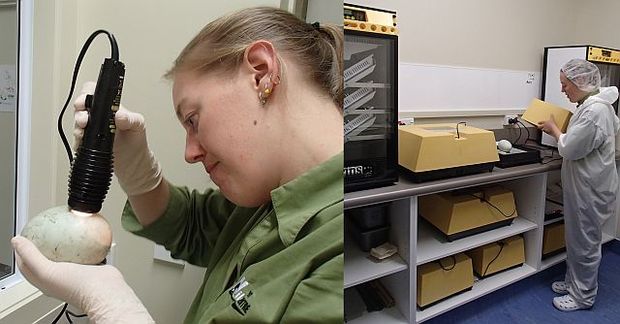
Kim Bryan-Walker checks the development of a rowi egg (left) before it is moved into an incubator at the West Coast Wildlife Centre (right) (images: Alison Ballance)
After hatching the chicks are kept in a brooder room at the centre for a few weeks, then they are moved to an outdoor pen to learn to forage independently before they are taken to the crèche island - Motuara Island in Queen Charlotte Sound – for a year or so.
The West Coast Wildlife Centre also looks after Haast tokoeka eggs and chicks.
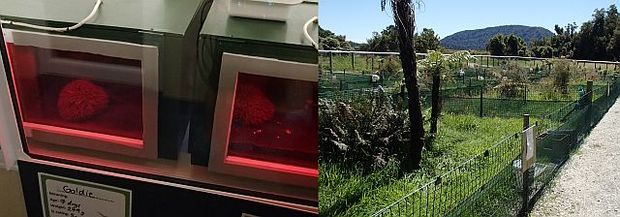
Two kiwi chicks sleeping in their brooder units, and the outdoor kiwi nursery where chicks get used to feeding themselves before they are moved to a predator-free creche island (images: A. Ballance)
Here’s an update on the egg from Kim Bryan-Walker at the West Coast Wildlife Centre:
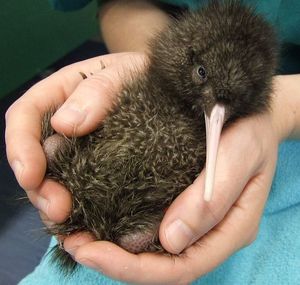 “A Harper’s egg produced a lovely little chick we called ‘Whittaker’ – our little chocolate Easter chick! Whittaker is pictured left at 5 days old (image courtesy of West Coast Wildlife Centre). The patch up of the toe print damage through the egg shell worked very well and kept everything nice and clean throughout incubation. Whittaker took 5 days to hatch and finally popped out on 21/3/14, weighing a very healthy 306.2 grams. Whittaker was a lovely bird to raise, with a very calm and curious personality. He had a slight hiccup and needed antibiotics when he was 7 days old, as he started scoffing a bit too much food too early and gave himself an upset tummy. That cleared up well and he has been happy and healthy ever since.
“A Harper’s egg produced a lovely little chick we called ‘Whittaker’ – our little chocolate Easter chick! Whittaker is pictured left at 5 days old (image courtesy of West Coast Wildlife Centre). The patch up of the toe print damage through the egg shell worked very well and kept everything nice and clean throughout incubation. Whittaker took 5 days to hatch and finally popped out on 21/3/14, weighing a very healthy 306.2 grams. Whittaker was a lovely bird to raise, with a very calm and curious personality. He had a slight hiccup and needed antibiotics when he was 7 days old, as he started scoffing a bit too much food too early and gave himself an upset tummy. That cleared up well and he has been happy and healthy ever since.
Whittaker has just been released into the Department of Conservation managed outdoor pens, so a very exciting new environment for him to explore, and he’ll be there for a month or so.
Whittaker is the 5th chick we have raised from the A Harper pair since starting with Operation Nest Egg at our facility in the 2010/11 season, so they are a very successful pair who produce very healthy chicks. Whittaker’s sibling from this season hatched in January this year and was called ‘Flapjack’ because the chick lived with a flatmate called ‘Pancake’. The chick called ‘Pancake’ was well known for sleeping stretched out flat on its stomach, like a pancake!
Whittaker was the last chick of the 2013-4 season for the West Coast Wildlife Centre – a busy season in which 75 rowi and Haast tokoeka chicks hatched.


